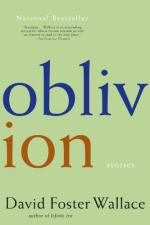|
This section contains 453 words (approx. 2 pages at 400 words per page) |

|
The Soul Is Not a Smithy Summary & Study Guide Description
The Soul Is Not a Smithy Summary & Study Guide includes comprehensive information and analysis to help you understand the book. This study guide contains the following sections:
This detailed literature summary also contains Quotes and a Free Quiz on The Soul Is Not a Smithy by David Foster Wallace.
The following version of this story was used to create this study guide: Wallace, David Foster. “The Soul is Not a Smithy.” Oblivion: Stories. New York: Hachette Book Group, 2004. 67-113. Print.
The story is told by an unnamed narrator in a retrospective fashion. He looks back upon a particular day in the year 1960 in Columbus, Ohio. The narrator was in the fourth grade, and his usual teacher was on maternity leave, so his class had a long-term substitute teacher named Richard Johnson. The narrator had attention and reading disabilities at that age, so he spent much of class time looking out the window and composing stories in his head. On the particular day in question, the narrator began to imagine a story about a blind girl named Ruth. Her pet dog, Cuffie, went missing one day when it was lured away by two other dogs. Ruth’s mother was an unsuccessful makeup salesperson, and her father was an overworked repairman for a wealthy businessman.
Distracted by the story, the narrator did not pay attention to the lesson, which was on the U.S. Constitution and the Bill of Rights. At one point, Mr. Johnson wrote the word “KILL” (84) in the middle of a sentence on the chalkboard, seemingly involuntarily. He erased the word and proceeded with the lesson. It soon occurred again, and then with more frequency. Mr. Johnson began writing “KILL THEM ALL” (91) repeatedly on the chalkboard. Meanwhile, the narrator’s imagined story grew darker, perhaps subconsciously influenced by the atmosphere in the classroom. Ruth was bullied at school, her father lost his hand to the rotating blades of a snow blower, and her mother died in a car accident while looking for Cuffie. The narrator briefly digresses to discuss the film The Exorcist, which contains a scene in which a horrific image flashes briefly across the screen, as if to embed itself in the viewer’s subconscious.
Eventually, most of the students in the classroom ran away, leaving only Mr. Johnson, the narrator, and three other students. The police eventually arrived and open fired upon Mr. Johnson, despite the fact that Mr. Johnson never turned towards them or even acknowledged that they were present. The narrator then briefly digresses to discuss his father. His father had been an actuary. The narrator knew that his father’s job was extremely boring, and the narrator feared becoming an adult and being stuck in a similarly boring job. The narrator discusses the idea of this boredom as being similar to the idea of death. The narrator ends the story by recalling a school presentation in which the students portrayed figures from American history and reenacted moments from American military history.
Read more from the Study Guide
|
This section contains 453 words (approx. 2 pages at 400 words per page) |

|



